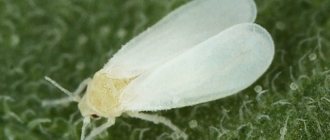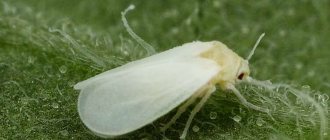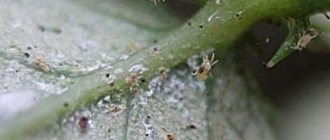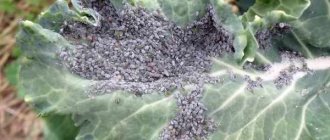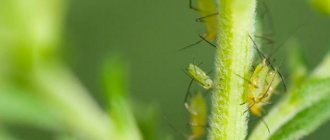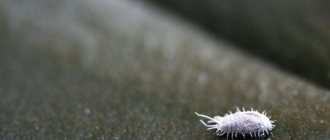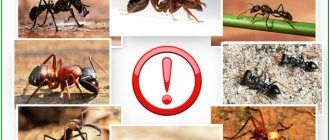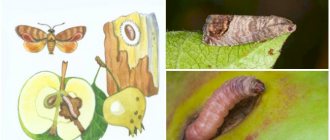A pest called whitefly affects houseplants: impatiens, begonias, geraniums, gerberas and gloxinias. Orchids, fuchsias, indoor pomegranates and dwarf tomatoes suffer from insects.
These parasites, once they have settled in pots, are difficult to remove. A wide range of means are used: from mechanical removal of larvae to biological and chemical insecticides. Traditional medicine also helps - garlic medicine, tobacco infusion, soap solution. But the most important part of treatment is identifying the causes and timely prevention of infection.
How to get rid of whiteflies at home?
Whitefly spreads from one infected plant to all indoor flowers. If larvae or flying specimens of this pest are found on one representative of the ornamental flora, take the following measures:
- Elimination of the affected flower. It is removed away from the “neighbors” and then mercilessly pruned. Remove damaged branches and shoots, and additionally change the soil.
- Climate change around. In the autumn-spring period, the pot is placed outside - already at 10°C the adult individuals die, and the larvae no longer develop. In summer, the flower is given a cold shower.
- Repeated treatment after 5-7 days. So the impact will cover both adult insects and larvae. Periodic treatment will completely get rid of the parasite.
Important! It will not be possible to remove the whitefly the first time - repeated treatment will be required after 5-7 days. Folk remedies do not harm ornamental plants.
Traditional methods for indoor flowers
The first stage of exposure to folk remedies is thoroughly wiping the leaves. To do this you need:
- Take clean water or a weak soap solution (1 tablespoon of shavings per 100 ml of water) and a sponge.
- Gently wipe the leaves.
- Repeat washing after 7 days, and then re-treat the culture until the parasites completely disappear. If necessary, you can additionally spray the leaves.
Peculiarity! The drug should not be whipped into foam and should not be allowed to get into the soil.
The list of simple and reliable mixtures against whiteflies includes infusions of garlic or tobacco. For the first you need:
- Chop 3 cloves of garlic.
- Pour 1 liter of water into the raw material and let it brew for a day in a dark place.
- Spray the infected leaves with the prepared infusion.
For tobacco infusion you should:
- Take 1 pack of cigarettes and grind the tobacco.
- Pour 1 liter of water over the raw material and put it in a dark place for 5 days.
- Strain the finished infusion and spray it on the diseased plant.
The procedure is repeated every 5-7 days to destroy whiteflies at all stages of development.
Glue traps and tapes
In between treatments of indoor plants with folk or industrial means, special traps are used to control pests. These devices are a piece of cardboard on which there is a layer of a substance that is safe for humans, but attractive to whiteflies.
Traps are usually painted yellow; parasites stick to them as soon as they are approached. Additionally, such products help fight spider mites and fungus gnats.
Traps are easy to make yourself. To do this, cut small pieces of thick cardboard and soak them in a mixture of:
- Vaseline;
- castor oil;
- honey;
- rosin.
When the pieces are dry, they are placed on a holder next to the pots.
Important! Similar products are also used in greenhouses - one product (10x10 cm) is enough for 10 square meters. m. area.
Sticky fly tapes can complement the traps if you place them in the window opening above containers with plants.
Fumigator
Fumigation devices with plates or liquid used to control mosquitoes will also help control whiteflies. A number of conditions must be met:
- place fumigators near plants;
- isolate the room with infected flowers (windows and doors);
- remove children and animals from the room.
Vapors from the plates and liquid become toxic in high concentrations, so after the procedure the room should be thoroughly ventilated. While the fumigators are working, being near them is dangerous to your health.
Fighting with chemicals
The following chemicals are suitable for exterminating whiteflies:
- Aktara. A systemic substance that provides about 3-5 weeks of flower protection. The product can be watered at the roots of flowers, as well as sprayed on the leaves. The main active ingredient, thiamethoxam, is mixed with the juice of an infected flora, after which adult parasites and their larvae feed on it. After the first exposure, whiteflies die within 7-10 days. The procedure is repeated a week later to consolidate the result.
- Confidor. The active ingredient is imidacloprid, thanks to which the product provides a systemic and contact effect on parasites. The death of the main population occurs after the first watering at the root of the plant. Secondary exposure (spraying the leaves) gets rid of the remaining pests after a week.
- Akarin. Contact-intestinal drug. After its use, the death of almost all individuals that absorb the poison along with food (plant juice) and through direct contact occurs. The peculiarity of application is that you need to pour the product into the root of the flower in one go, spray the leaves, and also try to capture the whitefly taking off.
- Spark. A product for watering indoor flora against parasites. The active component remains in the pot for up to 25 days, so the destruction of the entire colony is carried out after the first treatment.
Important! Chemical agents against whiteflies are the only and truly effective way to defeat this insect. Folk medicines are intended only to provide emergency assistance in case of infection, and also act as a means of prevention.
How to destroy manually?
It is imperative to manually fight whiteflies on houseplants. Such methods will not help get rid of the entire pest population, but with their help the number of parasites will be significantly reduced. Moreover, such methods will lead to limiting the spread of harmful insects.
Parasites can be manually destroyed in the following ways:
- placement of traps (purchased or made independently);
- collecting pests by hand every morning;
- watering the flower with a thin stream of cold water; in case of severe infection (if the leaves are covered with an adhesive substance), wiping with a sponge.
Peculiarity! Manual pest control also involves daily inspection of the infected plant and flowers located on the same windowsill. If detected, adults and larvae should be crushed immediately.
How to fight with biological means?
Among the biological preparations that effectively affect whiteflies, experts identify:
- Fitoverm. The product is contact-intestinal, absorbed into plant juice. Pests die within 3 days during feeding, as well as when the drug gets on the body. To increase the effectiveness of Fitoverm, it is recommended to mix it with a soap solution (1 ampoule per 2.5 l).
- Actellik. The period of death of parasites is 3-4 days. The drug is toxic, so when diluting the solution you should strictly follow the instructions and use personal protective equipment. It is not advisable to repeat treatments frequently. Actellik should be diluted in a ratio of 2 ml per 2 liters of water.
- Biotlin. The product has a detrimental effect on parasites at any stage of development. When using, protect skin and respiratory organs. Working solution – 5 ml of the drug per 10 liters of water.
How to fight whitefly
If you follow all the instructions for caring for house plants, and the whitefly still appears, get ready for a long fight against it. So how to get rid of whiteflies on indoor flowers?
Most often, whiteflies settle on indoor plants such as orchids, begonias, fuchsias, gerberas, indoor pomegranates, gloxinias, geraniums, balsams and others. When growing tomato seedlings at home, the likelihood of this dangerous insect appearing in your apartment on all indoor flowers increases.
Fighting whitefly with folk remedies
Let's look at several ways to combat whiteflies on indoor plants without chemicals.
- Try to isolate the diseased plant from the rest. Ruthlessly cut off severely damaged parts of it, change the soil under the flowers where possible.
- Place the flower pot in a place with lower temperature and humidity, because at temperatures less than 10 degrees. Celsius, the life cycle of the whitefly is suspended, the adults die, and the larvae stop developing. Cold-resistant varieties of indoor plants can be placed under an open window or placed on the balcony for several days without harming them.
- A very effective method of dealing with flying moths is to collect them using a vacuum cleaner.
- It is also effective to place the pot with the affected flower under a cold shower in the bathroom. If you wash all the affected areas of the plant well, most of the parasites will be washed off and die.
- You can also spray your diseased flowers with a soap solution. To prepare it, 1 tbsp. dissolve finely grated laundry soap in 6 liters. warm water. Try not to let the soap solution get into the soil.
- Garlic infusion also destroys clusters of parasites. 3 cloves are crushed and poured into 1 liter of water. This mixture stands in a dark place for 24 hours. After this, the liquid is filtered and sprayed on the diseased plant.
- You can also remove whiteflies from indoor plants using shag or strong cigarettes. One pack per liter of hot water is enough. Let the solution brew in a dark place for 5 days, strain and spray the affected indoor plants.
- Another way to treat an infected plant is with dichlorvos. The pot with the plant is placed in a spacious plastic bag. A piece of cotton wool heavily treated with dichlorvos is also placed there. The bag is tied tightly and placed on a balcony or in a non-residential premises for 4-5 hours. After this, the flower pot is removed from the bag, washed in the bathroom, dried and put back in place under the supervision of the florist.
- To combat whiteflies, some amateur gardeners use ordinary fumigators against mosquitoes and midges. If you want to use this method, then close all windows and doors, turn on the fumigator closer to the diseased plant and leave. People and animals are not allowed to be in this room while the fumigator is operating - there is a risk of poisoning.
This may be interesting: Blackleg - combating the disease
All of the above methods for combating whiteflies are traditional. You must understand that you will not get rid of such a numerous pest as whitefly in one go. With a single treatment, only adult individuals die, while larvae in cocoons and eggs in protective shells often remain alive. Therefore, it is necessary to treat home flowers several times, with breaks of 5-7 days until the parasite is completely destroyed. Don't worry - folk remedies do not harm the plant.
Glue traps and tapes
To combat whiteflies, you can also use sticky traps. These are small cardboard or plastic plates, on which a layer of special entomological glue that does not dry in air is applied on both sides. It is non-toxic, odorless and colorless. Traps should be installed above or close to the flower pot. The traps themselves are brightly colored yellow. It is believed that this color attracts whiteflies; they flock to it from all sides and stick to the adhesive surface at the slightest touch.
Whitefly trap
If desired, you can make a whitefly trap with your own hands. Paint a piece of thick cardboard or plywood bright yellow and apply Vaseline or castor oil to the dried surface. You can install your invention directly in a pot using a holder or on a windowsill near a diseased plant.
Sticky fly tapes also work similar to sticky traps. They are also hung over flower pots affected by whiteflies or other flying midges.
Chemical control agents
How to destroy whiteflies on indoor plants if all folk remedies have been tried, but the whitefly continues to fly over the flowers? The time has come to use more powerful, chemical means of protection against whiteflies on indoor plants. The following drugs for controlling whiteflies are believed to be the most effective:
- Aktara. This is a systemic drug. It has a long period of effect on insects (from 3 to 5 weeks of protection). According to the instructions, you can water the diseased plant at the root with this drug and you can spray it. Aktara's destructive substance (thiamethoxam) enters the flower sap through the pores and roots of the plant, which both adults and larvae feed on. We recommend watering the affected plant with a strong solution of this drug, stronger than what is written on the package. The plant will not be harmed, and the entire colony of parasites will die almost 100% within 7-10 days. In case of very severe damage to indoor flowers by whitefly, it is necessary to repeat the treatment with Aktara a couple more times with breaks a week in order to be guaranteed to get rid of the sucking parasite.
- Confidor. It is an insecticide of systemic and contact action. When you use it, insects begin to die right before your eyes. The main population dies after a single watering at the root. But it is recommended to re-treat the infected plants after a week to consolidate the result. Other drugs with the same active ingredient (imidacloprid) are also used: KOMANDOR, APPLAUD, KOPFIDOR, MARATHON, GAUCHO.
- Akarin. It is an insectoacaricide of contact-intestinal action. It penetrates the parasite through food and direct contact. Almost all individuals parasitizing your plants die. It is necessary to thoroughly moisten all the leaves and stems of the plant by spraying, try to fill the entire colony of pests with this solution and get on the whitefly even when it flies up from the plant in a white cloud.
- Spark. This drug is available in different forms: water-soluble tablets, powder, liquid in ampoules or sticks. All this is used to water the plant affected by pests at the root. The active substance has a long period of plant protection. It remains in roots and tissues for up to 25 days and is thus a poison that kills the entire population of whiteflies in one treatment.
This may be interesting: Powdery mildew, Anthracnose and other spots and their treatment
In addition to those listed, the following are used to destroy whiteflies on indoor plants: Fitoverm, Actellik, Zeta, Fufanon, Alatar. (Read packages for instructions)
When treating whitefly-affected flowers, do not ignore your other indoor plants. We advise you to inspect them regularly, remove dried leaves and faded flowers, ventilate them more often and regularly wash the leaves and other parts of the plant with soapy water. To prevent the disease, you can even treat all flower plantings with some folk remedy. It is better to prevent a dangerous disease than to deal with multiplying parasites later.
What does a whitefly look like?
The whitefly is a small parasitic insect that survives by feeding on plant sap from punctures in the leaves. The activity of parasites leads to drying out of flowers and even to their death.
More than 200 species of insects are capable of harming various crops, but greenhouse parasites are the most dangerous for ornamental crops. They usually move to indoor flora from vegetables (for example, from dwarf tomatoes).
The insect development cycle takes place in the following stages:
- Adults lay ring-shaped eggs on the leaves of domestic plants.
- The eggs hatch into larvae that are mobile and secrete a dense substance to protect them from external influences and secure them in their habitat.
- The larvae form cocoons in which the organs of future adult insects are laid.
- Individuals emerge from cocoons, attach to the leaves of the plant and begin to actively feed.
Important! After emerging from the cocoons, the whiteflies are covered with a waxy coating, which protects the parasites from all drugs and means of influence. That is why it is necessary to repeat treatment with insecticides or folk remedies every 5-7 days.
Description
Externally, the whitefly looks like a small moth with the following characteristics:
- body length – about 0.9 mm;
- The body color of an adult is yellow, the wings are white, without spots or inclusions;
- the head is equipped with thin light yellow antennae.
The larva goes through 4 stages of development, each of which looks different:
- at the first stage the larva has no wings, the body length is 0.3 mm, there are antennae and legs; after the start of feeding, the body becomes covered with a waxy coating;
- at the second stage, the parasite acquires small shiny scales, antennae and legs are rudimentary;
- at the third stage, the larvae are covered with a waxy coating, the bodies are colored green, and red eyes stand out on the front parts of the body;
- at the final stage, the larva grows to 0.75-0.8 mm, its body swells, and its shape changes.
Peculiarity! At the last stage of development, the larvae are openly located on the underside of the leaf. Here they are clearly visible, as a result of which the infection of the plant becomes obvious.
Kinds
Of the 200 species of whiteflies that harm ornamental flora:
- greenhouse (greenhouse) - a heat-loving variety whose usual habitat is greenhouses and houses;
- cotton (tobacco) - a parasite that actively reproduces in conditions of high heat and humidity;
- giant - the most dangerous species for ornamental plants; externally, its larvae differ from other varieties by long waxy stripes;
- citrus - prefers gardenias, hibiscus and ficus among decorative flowers.
The main danger to house flowers is the greenhouse whitefly, which actively reproduces in a favorable (warm and humid) atmosphere.
Photo
In the photo you can clearly see the plants on which whiteflies have settled:
- small punctures of leaf blades in places where parasites sucked out plant sap;
- yellowish dots on the leaves, gradually increasing in diameter and in number;
- sooty coating on the back surface of the leaves, on the outer surface there are clutches of eggs (yellowish, small, laid out in circles);
- a coating of so-called honeydew on the surface - traces of excrement of parasite larvae, which become a breeding ground for fungal infections.
Adult whiteflies are small, but you can see them, especially when the insects gather in swarms. The larvae are noticeable by traces of their vital activity, which remain on the leaves.
Pest destruction methods
For whiteflies, you can use both homemade preparations made according to folk recipes and ready-made purchased products. In addition, biological control methods are often used to combat this pest. Let's look at each category in more detail.
Biological methods
These methods have recently gained enormous popularity as they help maintain the environmental purity of the crop. Moreover, such methods are used mainly in greenhouses and greenhouses, and for their implementation they resort to the help of parasitic insects.
- Encarzia - for 2 m2 you will need only three insects. Female parasites lay eggs in the body of whitefly larvae, after which they begin to feed on their tissues. As a result, all larvae die.
On a note! The use of encarsia shows high efficiency in the fight against whitefly on tomatoes. You should not use this parasite on cucumbers, since this plant is covered with dense hairs that prevent the encarsia from reaching the whitefly larvae!
- Macrolophus is a bug that will help destroy whiteflies on peppers and tomatoes. For 1 m2 you will need five bedbugs.
Popular drugs
Most chemicals are effective because they penetrate the plant's body and poison its juices. A whitefly, having drunk poisoned juices, dies almost immediately. Other drugs, being insectoacaricides of intestinal contact action, cause paralysis and subsequent death of insects.
Important! However, it should be remembered that even the most effective chemicals are not capable of destroying eggs, so treatment is usually carried out twice with an interval of 7 days!
When working with an insecticide, the handler must use personal protective equipment, and after using the drug, you should immediately leave the premises and limit access to people and animals.
- “Fitoverm” is a drug that is quite often used against whiteflies in greenhouses. It is created on the basis of waste products of soil microorganisms, and therefore does not pollute the environment. It is advisable to use it no later than two days before harvest. The treatment is carried out in clear, dry weather using any sprayer that is capable of evenly spraying fine particles of the toxic substance.
Important! Precipitation and heavy dew can significantly reduce the effectiveness of this drug!
- “Confidor” copes very quickly with greenhouse whiteflies and works well even against those pests that have become resistant to insecticides from the pyrethroid class and organophosphorus preparations. It exhibits an intestinal-contact effect - once it enters the insect’s body, it blocks the course of the nerve impulse, which leads to paralysis and early death. The effect after treatment is observed after 3 hours.
- "Aktara" is a systemic insecticide based on thiamethoxam. Can be used to protect both indoor and garden crops. After applying the working solution, the active substances penetrate into the tissues of plant leaves, but the poison practically does not get into the fruits.
- “Actellik” is an insectoacaricide that shows excellent results in the fight against many types of pests of flowers and garden plants, including whiteflies. Its fumigation effect is enhanced in a warm, humid environment, but the air temperature should not be higher than +15°C.
Important! If the air temperature in a greenhouse or outside reaches +25...+30°C, then treatment with Actellik is not carried out!
- “Match” is a contact-intestinal insecticide, which is available in liquid form. Effectively protects fruit and vegetable crops from a wide range of pests. To completely destroy whiteflies, it is necessary to perform one, or less often two, treatments. After use, it continues to protect vegetable crops for two weeks, fruit crops for about a month.
- "Aplaud" is a wetting powder from whiteflies, which is a regulator of the synthesis of chitinous parasites. It has a prolonged effect, working for 25 days. During the molting period, the drug destroys the larvae, while adults, after contact with this product, lay only non-viable eggs. Thus, it is possible to destroy the entire pest population. It is recommended to spray plants once when insects are detected.
- "Biotlin" - shows high efficiency in the fight against whiteflies in greenhouses and hotbeds. This product is a systemic insecticide, from which insects die a few hours after treatment. It is not addictive and prevents the emergence and development of new pest colonies.
Recommendation! To make the working solution of the above preparations work more effectively, you can add a small amount of grated laundry soap to it - this will ensure excellent adhesion of the product to the leaves and stems of plants!
DIY preparations and remedies
In parallel with the use of chemicals, glue traps can be hung in the greenhouse and above indoor plants. These are usually used against flies. There are also traps on sale that are installed directly in pots or on beds.
Besides:
- Garlic infusion is very effective against whiteflies. To prepare it, chop 160 g of garlic and add a liter of water to the resulting mass. The finished mixture is tightly sealed and left for five to seven days in a dark place. Before treatment, 6 g of the resulting drug is diluted in a liter of water, then the infected plants are sprayed.
- Another pretty good drug for whiteflies is benzyl benzoate. It is used as follows: 50 ml of emulsion must be diluted in a liter of water. The plants are treated with the prepared product immediately after preparation.
- An infusion of tobacco can also very quickly rid your crops and flowers of whiteflies. To prepare it, dried tobacco must be soaked in water and left for two days. We spray the plants affected by the pest with the resulting product.
If the infected area is small or indoor plants are affected, then in this case it is quite possible to get rid of the whitefly mechanically - by wiping the leaves with plain water or a weak soap solution. By acting carefully and carefully, you can remove absolutely all the larvae located on the underside of the leaf plates.
In addition, it is known that the whitefly is a heat-loving insect and does not tolerate low air temperatures. Therefore, if it was found on indoor plants, then for a while they can be taken out to the balcony.
Important! Just make sure that the air temperature is not too low, as your flowers may die along with the insects!
Reasons for appearance on plants
The causes of infection of decorative flora are the same for all types of this parasite:
- the presence of a favorable habitat (high humidity and significant heat);
- spread of pests from a diseased plant or by transplanting flowers into larvae-infested soil;
- entry of adults through a window;
- movement of the pest from the indoor greenhouse in which cuttings and seedlings were rooted.
Important! Warmth, dampness, dense arrangement of ornamental plants, as well as their growth in stale air create a favorable environment for the development and reproduction of the parasite. Just regular ventilation can seriously reduce the risk of infection.
Signs of indoor plant infection
Whitefly infestation is visually detected by the following manifestations:
- the presence of larvae and laid eggs of the parasite on the underside of the leaves;
- a swarm of small butterflies that appear if you shake the flower a little;
- shiny sticky (waxy) coating on the leaves;
- spots of yellow, gray and black color, which indicate infection by pest eggs, and later by fungi;
- general deterioration in the appearance of the flora - yellowing of leaves, their curling, poor crop growth, signs of wilting.
If the listed symptoms appear, you should not only immediately isolate the affected plant, but also check the condition of neighboring bushes.
Pest control methods
In one period of time, individuals of all stages of development are present on one plant, some of which are resistant to the action of pesticides and insecticides. This makes pest control much more difficult. Various methods are used: from folk remedies to biological and industrial insecticides.
Folk remedies
Traditional methods of control involve spraying infected plants with homemade liquids that repel the pest:
- Soap solution. 200 g of finely grated tar soap are diluted in 2 liters of warm water. The solution is carefully mixed, trying to prevent the formation of fluffy foam. The prepared liquid is sprayed onto the plants, and the foam is applied to the back of the leaves. Repeated treatment is carried out after 7-10 days.
- Garlic infusion. The head of garlic is grated on a fine grater or passed through a press and 2 liters of warm water are added. The mixture is stirred and left in a dark place for 1 day. The resulting infusion is sprayed onto the affected crops. To destroy whiteflies, 2-3 procedures are carried out with an interval of 3-5 days.
- Tobacco infusion. Tobacco is removed from a pack of strong cigarettes and 1 liter of hot, but not boiling, water is poured into it. The mixture is placed in a dark place for 5 days. The finished infusion is filtered and the damaged crops are sprayed with it. Treatment is carried out once every 3 days until the insects are completely destroyed.
Folk remedies are recommended to be used in the initial stage of the appearance of whiteflies, when the number of individuals can still be regulated in this way. In case of mass infection, you need to move on to the “heavy artillery” - insecticides and pesticides.
Biological insecticides
It is advisable to apply biological protection measures in a small planting area. The advantage of natural whitefly control methods is that they do not harm plants, humans, animals or beneficial insects.
Predatory parasitic insects (encarsia or macroflorus bug) - natural enemies of the whitefly - are used as an insecticide. Predatory insects can be purchased in specialized stores or laboratories: eggs are sold in packages of 50 or 100 pieces.
Directions for use:
- encarsia are populated once in an amount of 3 individuals per 1 sq. m of infected plantings;
- The macroflorus bug is released 2 times, 5 individuals per 1 sq. m with an interval of 2 weeks.
The disadvantage of this method is that predators do not completely destroy the whitefly population, leaving a small part of it to feed their offspring. The next generations do the same. Therefore, biological control methods are recommended for preventive purposes or for minor lesions.
Chemicals
Chemical control begins immediately upon detection of the pest. During the growing season, plants are treated with the following preparations:
- neonicotinoids (“Aktara”, “Konfidor”);
- pyrethroids (Talcord, Folkard);
- organophosphorus compounds (“Karbofos”, “Chlorophos”);
- inhibitors of chitin synthesis (“Match”, “Lufox”).
Pesticides are recommended to be used in a mixture with adhesives - laundry soap or industrial products (Tandem, Atomic, Liposam).
Chemical treatment is carried out in dry, clear weather. For personal protection, use rubber gloves, overalls, and a respirator.
Mechanical method
You can get rid of pests using glue traps - small yellow pieces of cardboard or plastic, on the surface of which a non-drying adhesive composition is applied. The yellow color of the plate reflects light at a wavelength that attracts insects. The adhesive composition does not use pesticides or insecticides, so the traps do not pose a danger to humans and pets. The plates are hung directly above the plants.
The “bonus” of mechanical pest trapping is its versatility: the traps catch not only whiteflies, but also aphids, thrips, flies, spider mites, and fungus gnats. Adhesive sheets can be purchased in specialized stores or departments for gardeners and vegetable gardeners.
Prevention Tips
To prevent infection of indoor flowers by parasitic insects, the following preventive measures are recommended:
- avoiding stagnation of water in trays under pots after watering;
- placing plants at a distance from each other to avoid increased crowding;
- quarantine up to 7 days for each new flower;
- regularly ridding bushes of dead branches, dried leaves and inflorescences;
- keeping the plant under regular ventilation conditions;
- using only tested or thoroughly sterilized soil;
- shower days - regularly wipe the leaves and wash them under running cool water;
- use of growth stimulants and fertilizers.
The health of ornamental plants depends on how much the owner takes care of them. Correct growing conditions, attentive attention to the slightest changes in condition, properly applied fertilizing - all this is the key to the health of flowers.
It is important to prevent the appearance of whiteflies in time than to fight parasites with folk or industrial means.
5 / 5 ( 1 voice )
Fighting whitefly with folk remedies
The easiest way to get rid of whiteflies is to wipe the leaves with a sponge soaked in water. Using this simple procedure, you can destroy a large number of both adult insects and larvae. However, it can only be used when the whitefly has taken a fancy to the indoor plant. To reduce the number of pests, it is enough to perform the procedure at least once every 10 days.
To make this method more effective, you can use a soap solution rather than ordinary water. To prepare it, you need to grind laundry soap and dissolve it in water in a ratio of 1:6. You need to wipe the leaves with a solution that has been previously whipped into foam. The same liquid can be used to spray infected plants. This must be done carefully, trying to ensure that the solution does not get on the ground.
Another method of combating whiteflies is the use of garlic infusion. To prepare it, you need to chop several garlic cloves, immediately fill them with water (1 liter) and leave to infuse in a dark place. After 24 hours, the solution can be filtered and the spraying procedure can be started. It can be repeated as necessary.
You can get rid of whiteflies on flowers using tobacco. To do this, you need to buy one pack of good cigarettes, grind them well, fill them with hot water (1 liter) and leave them to infuse in a dark place. After 5 days, you can spray, having first filtered the resulting solution. The procedure should be carried out once every 3 days until the pests disappear completely.
